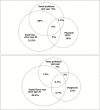Prevalence and Risk Factors of Self-Reported Smell and Taste Alterations: Results from the 2011-2012 US National Health and Nutrition Examination Survey (NHANES)
- PMID: 26487703
- PMCID: PMC4715252
- DOI: 10.1093/chemse/bjv057
Prevalence and Risk Factors of Self-Reported Smell and Taste Alterations: Results from the 2011-2012 US National Health and Nutrition Examination Survey (NHANES)
Abstract
Chemosensory problems challenge health through diminished ability to detect warning odors, consume a healthy diet, and maintain quality of life. We examined the prevalence and associated risk factors of self-reported chemosensory alterations in 3603 community-dwelling adults (aged 40+ years), from the nationally representative, US National Health and Nutrition Examination Survey (NHANES) 2011-2012. In this new NHANES component, technicians surveyed adults in the home about perceived smell and taste problems, distortions, and diminished abilities since age 25 (termed "alterations"), and chemosensory-related health risks and behaviors. The prevalence of self-reported smell alteration was 23%, including phantosmia at 6%; taste was 19%, including dysgeusia at 5%. Prevalence rates increased progressively with age, highest in those aged 80+ years (smell, 32%; taste, 27%). In multivariable logistic regression, controlling for sociodemographics, health behaviors, and chemosensory-related conditions, the strongest independent risk factor for smell alteration was sinonasal symptoms (odds ratio [OR] = 2.06; 95% confidence interval [CI]: 1.63-2.61), followed by heavy drinking, loss of consciousness from head injury, family income ≤110% poverty threshold, and xerostomia. For taste, the strongest risk factor was xerostomia (OR = 2.65; 95% CI: 1.97-3.56), followed by nose/facial injury, lower educational attainment, and fair/poor health. Self-reported chemosensory alterations are prevalent in US adults, supporting increased attention to decreasing their modifiable risks, managing safety/health consequences, and expanding chemosensory screening/testing and treatments.
Keywords: dry mouth; dysgeusia; head injury; health status; phantosmia.
© The Author 2015. Published by Oxford University Press. All rights reserved. For permissions, please e-mail: journals.permissions@oup.com.
Figures

References
-
- Aschenbrenner K, Hummel C, Teszmer K, Krone F, Ishimaru T, Seo HS, Hummel T. 2008. The influence of olfactory loss on dietary behaviors. Laryngoscope. 118(1):135–144. - PubMed
-
- Bartoshuk LM, Catalanotto F, Hoffman H, Logan H, Snyder DJ. 2012. Taste damage (otitis media, tonsillectomy and head and neck cancer), oral sensations and BMI. Physiol Behav. 107(4):516–526. - PubMed
-
- Bergdahl M, Bergdahl J. 2002. Perceived taste disturbance in adults: prevalence and association with oral and psychological factors and medication. Clin Oral Investig. 6(3):145–149. - PubMed
-
- Brämerson A, Johansson L, Ek L, Nordin S, Bende M. 2004. Prevalence of olfactory dysfunction: the skövde population-based study. Laryngoscope. 114(4):733–737. - PubMed
Publication types
MeSH terms
Grants and funding
LinkOut - more resources
Full Text Sources
Other Literature Sources
Medical

